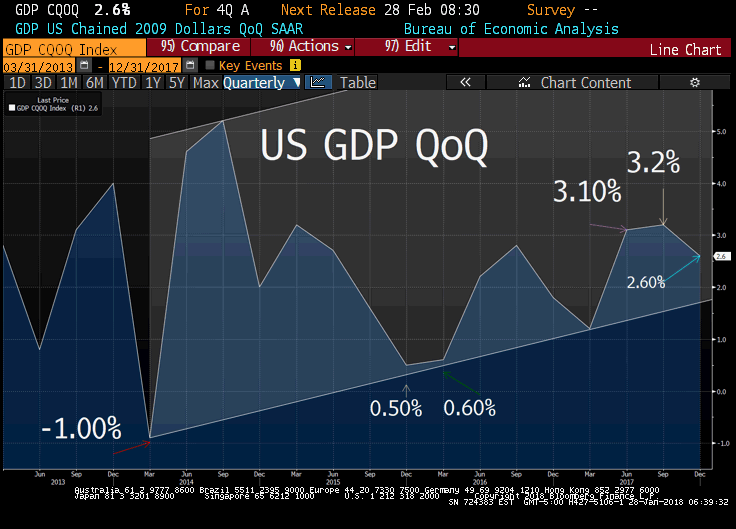Join our Larry McDonald on CNBC’s Trading Nation, Wednesday at 3:05pm ET
Pick up our latest report here:
Don’t miss our next trade idea. Get on the Bear Traps Report Today, click here“We believe inflation is set to finally pick up in 2018. Much of the passive and quant-side (a $1.5T shift in asset management) has become heavily invested in the “risk parity” model which involves being long equities and bonds on a risk-adjusted basis. One of the fundamental problems with this strategy is you’re effectively really long disinflation. Sure, it’s worked very well in the post great financial crisis period, but it’s a grossly crowded trade and has all the makings of a gruesome slaughterhouse. In this case, the risk tail is a period where equities and bonds fall together, which is not that uncommon in a late cycle inflationary environment (see 1980s and 1990s). Other than out of the money puts in rates (bonds) a big way for these guys to hedge inflation is to increase commodity exposure. As long-time bulls, we’re now ‘pounding the table’ bond bears for 2018.”
Bear Traps Report, January 2, 2018
 The 2.6 percent headline rate doesn’t do justice to fourth-quarter GDP where consumer spending rose a very strong 3.8 percent that reflects a 14.2 percent burst in durable spending. Bloomberg noted Residential investment, which is another consumer-related component, rose at a very impressive 11.6 percent annualized rate. Turning to business spending, nonresidential fixed investment rose at a 6.8 percent rate which is the fourth straight mid-single digit result.
The 2.6 percent headline rate doesn’t do justice to fourth-quarter GDP where consumer spending rose a very strong 3.8 percent that reflects a 14.2 percent burst in durable spending. Bloomberg noted Residential investment, which is another consumer-related component, rose at a very impressive 11.6 percent annualized rate. Turning to business spending, nonresidential fixed investment rose at a 6.8 percent rate which is the fourth straight mid-single digit result.
What does this mean for bonds? We have an important note coming out, pick it up here.
Government purchases at a 3.0 percent rate, also added to GDP in the quarter. What pulled down fourth-quarter GDP were net exports, at an annualized deficit of $652.6 billion, and inventories which rose at a slower rate than the third quarter. Looking at final sales to domestic buyers, which excludes inventories and exports, GDP comes in at a robust 4.3 percent.
Prices also showed some vigor in the quarter, with the index at 2.4 percent vs the third quarter’s 2.1 percent. This is a standout report led by the consumer that shows the economy accelerated into year-end 2017 with strong momentum going into 2018.
What are the key Takeaways?
There are both positive and negative views that can be extrapolated from today’s data.
- The consumer savings rate fell to its lowest since November 2007, down from 3.3% to 2.6%. If it had stayed the same, Real PCE would have been 0.8% (annualized) instead of 3.8% and GDP would have been 0.6% instead of 2.6%. Clearly, business and consumer confidence levels are nearly 2 standard deviations higher than the 1010-16 mean, thus spenders seem to be more confident dipping into savings with visions of better times ahead.
- The GDP came in lower than expectations, but net of hurricane-impacted inventories and exports, 4.3% is an objectively impressive number.
Pick up our latest report here:
Don’t miss our next trade idea. Get on the Bear Traps Report Today, click hereLooking ahead into Q1, and Beyond
This adjusted 4.3% rate isn’t unprecedented growth, however, even in recent memory. We saw 3% YoY in first half 2015. So, then, how sustainable is the growth? In the short term, a decreasing savings rate will boost demand. The near-term outlook is bond bearish, and it should be. Prices are rallying, savings are down, and over the next quarter or two we should see some legs on consumer demand; something that has been notably weak in recent memory. There is a reason to be optimistic into early 2018 from a consumer spending perspective, and perhaps even beyond, depending on the timeline for infrastructure spending.
Economic activity built on a foundation of lower savings, in the absence of wage growth, will eventually drag output lower. Lower consumer savings is likely overstated; we regularly see upward revisions.
Cycle-low savings rates don’t stay low forever. Companies have shown a resilient hesitation toward raising wages. Americans are borrowing to finance their own spending and with any reasonable stall in consumer spending into 2018, our current annualized growth rate will be under significant pressure.
Pick up our latest report here:
Don’t miss our next trade idea. Get on the Bear Traps Report Today, click here


